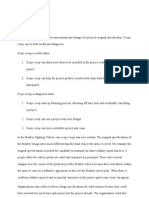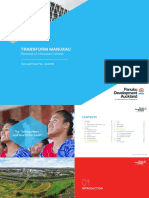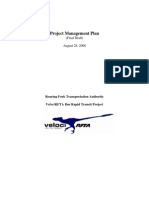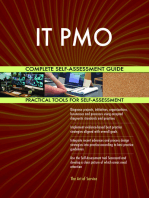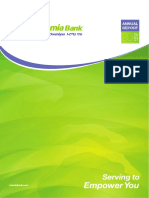Project Management Plan 1
Project Management Plan 1
Uploaded by
r.jeyashankar9550Copyright:
Available Formats
Project Management Plan 1
Project Management Plan 1
Uploaded by
r.jeyashankar9550Original Description:
Copyright
Available Formats
Share this document
Did you find this document useful?
Is this content inappropriate?
Copyright:
Available Formats
Project Management Plan 1
Project Management Plan 1
Uploaded by
r.jeyashankar9550Copyright:
Available Formats
[INSERT PROJECT NAME]
PROJECT MANAGEMENT PLAN
(PMP)
EXECUTIVE SPONSOR [INSERT NAME]
BUSINESS OWNER - [INSERT NAME]
PROJECT MANAGER [INSERT NAME]
ORIGINAL PLAN DATE: [INSERT DATE, SPELLED OUT]
REVISION DATE: [INSERT DATE, SPELLED OUT]
REVISION: [INSERT NUMBER]
Project Management Plan
TABLE OF CONTENTS
About This Document...................................................................vi
Revision History...........................................................................vii
1.0 Project Overview...................................................................1
1.1
1.2
1.3
1.4
INTRODUCTION................................................................................. 1
CURRENT STATE...............................................................................1
FUTURE STATE..................................................................................1
NEED..................................................................................................1
2.0 Scope......................................................................................... 1
2.1 PROJECT JUSTIFICATION......................................................................1
2.2 PROJECT OBJECTIVES..........................................................................1
2.2.1 BUSINESS OBJECTIVES......................................................................................1
2.2.2 TECHNICAL OBJECTIVES...................................................................................1
2.3 DELIVERABLES......................................................................................1
2.3.1 PROJECT MANAGEMENT DELIVERABLES........................................................1
2.3.1.1 [DELIVERABLE 1 NAME].............................................................................1
2.3.1.2 [DELIVERABLE 2 NAME].............................................................................2
2.3.2 PRODUCT DELIVERABLES.................................................................................2
2.3.2.1 [DELIVERABLE 1 NAME].............................................................................2
2.3.2.2 [DELIVERABLE 2 NAME].............................................................................2
2.3.3 DELIVERABLE APPROVAL AUTHORITY DESIGNATIONS...................................2
2.3.4 DELIVERABLE ACCEPTANCE PROCEDURE.......................................................2
2.4 WORK BREAKDOWN STRUCTURE (WBS)...........................................2
3.0 Overall Strategy....................................................................... 2
3.1 PROJECT MANAGEMENT LIFE CYCLE................................................2
3.2 CRITICAL SUCCESS FACTORS.............................................................. 2
3.3 PROJECT LOGISTICS.............................................................................3
3.4 PROJECT PRODUCT LIFE CYCLE MODEL...........................................3
3.5 TECHNICAL STRATEGY.........................................................................3
4.0 Project Organization............................................................... 3
4.1 STAKEHOLDERS.....................................................................................3
4.2 CUSTOMERS...........................................................................................3
4.3 PROJECT TEAM.....................................................................................3
4.3.1 PROJECT TEAM ORGANIZATIONAL BREAKDOWN STRUCTURE......................3
4.3.2 PROJECT TEAM ROLES AND RESPONSIBILITIES..............................................3
5.0 Project Management and Controls........................................ 3
5.1 STAFFING PLANNING AND ACQUISITION............................................. 3
5.2 ASSUMPTIONS........................................................................................4
Project Management Plan
ii
5.3 CONSTRAINTS........................................................................................4
5.4 DEPENDENCIES......................................................................................4
5.4.1 MANDATORY DEPENDENCIES............................................................................4
5.4.2 DISCRETIONARY DEPENDENCIES......................................................................4
5.4.3 EXTERNAL DEPENDENCIES...............................................................................4
5.5 RISK MANAGEMENT.............................................................................4
5.5.1 RISK MANAGEMENT STRATEGY.......................................................................4
5.5.2 PROJECT RISK IDENTIFICATION.......................................................................5
5.5.3 PROJECT RISK ANALYSIS..................................................................................5
5.5.3.1 [RISK 1 NAME]............................................................................................5
PROBABILITY AND IMPACT -......................................................................................5
5.5.3.2 [RISK 2 NAME]............................................................................................5
PROBABILITY AND IMPACT -......................................................................................5
5.5.4 PROJECT RISK MITIGATION APPROACH..........................................................5
5.5.5 RISK REPORTING AND ESCALATION STRATEGY..............................................5
5.5.6 PROJECT RISK TRACKING APPROACH.............................................................5
5.6 INDEPENDENT VERIFICATION AND VALIDATION - IV&V..................5
5.7 SCOPE MANAGEMENT PLAN................................................................5
5.8 ISSUE MANAGEMENT............................................................................5
5.8.1 INTERNAL ISSUE ESCALATION AND RESOLUTION PROCESS...........................5
5.8.2 EXTERNAL ISSUE ESCALATION AND RESOLUTION PROCESS..........................5
5.9 PROCUREMENT MANAGEMENT PLAN................................................. 5
5.10 CHANGE CONTROL.............................................................................5
5.10.1 CHANGE CONTROL PROCESS..........................................................................5
5.10.2 CHANGE CONTROL BOARD (CCB).................................................................5
5.11 PROJECT TIMELINE............................................................................ 5
5.12 PROJECT BUDGET...............................................................................6
5.12.1 BUDGET TRACKING.........................................................................................6
5.13 COMMUNICATION PLAN..................................................................... 6
5.13.1 COMMUNICATION MATRIX..............................................................................6
5.13.2 STATUS MEETINGS...........................................................................................6
5.13.3 PROJECT STATUS REPORTS.............................................................................6
5.14 PERFORMANCE MEASUREMENT (PROJECT METRICS).....................6
5.14.1 BASELINES........................................................................................................6
5.14.2 METRICS LIBRARY..........................................................................................6
5.15 QUALITY OBJECTIVES AND CONTROL..............................................6
5.15.1 CUSTOMER SATISFACTION..............................................................................6
5.15.2 DELIVERABLE DEFINITION..............................................................................6
5.15.3 DELIVERABLE QUALITY..................................................................................6
5.15.4 PROJECT/PRODUCT DELIVERABLE PRESENTATION......................................6
5.16 CONFIGURATION MANAGEMENT.......................................................6
5.16.1 VERSION CONTROL..........................................................................................6
5.16.2 PROJECT REPOSITORY (PROJECT LIBRARY).................................................6
6.0 Project Close.............................................................................7
ii
Project Management Plan
iii
6.1 ADMINISTRATIVE CLOSE......................................................................7
6.2 CONTRACT CLOSE................................................................................7
7.0 Glossary.................................................................................... 8
7.1 ACRONYMS AND ABBREVIATIONS........................................................8
7.2 DEFINITIONS..........................................................................................8
iii
Project Management Plan
iv
LIST OF FIGURE
Error! No table of figures entries found.
iv
Project Management Plan
LIST OF APPENDICE
Appendix A: Work Breakdown Structure
Appendix B: Project Schedule
Appendix C: Form
Appendix D:
Appendix E:
Appendix F:
Appendix G:
Appendix H:
Project Management Plan
vi
ABOUT THIS DOCUMENT
This document is a template that provides the industry accepted guidelines to plan,
execute, control, and close a project. This document will need to be tailored and
customized to the needs of the project; however, special care should be considered if
major sections are tailored out.
1. Tailoring is the process that modifies the structural components of the template
to the needs of a specific project. As an example, the Project Manager may have a
standard appendix that does not apply to the project.
2. Customization is the mechanical task of inserting customer or project logos,
deliverable identifiers, names, and so on, into a copy of the template. The copy
then becomes the live version of the Project Management Plan for the project and
will need to be updated, as project conditions require.
3. Any level of tailoring can be applied to the template, as long as the PMO is
advised. This notification has several purposes:
a. It allows Quality Assurance to adjust checklists and questionnaires,
b. It allows the Program Management Office (PMO) to adjust its oversight
and QA activities to the projects plan,
c. It allows the PMO to advise the project team of the potential effects and
risks that may occur if materials are omitted, and
d. It serves as a trigger for possible improvement of the template by the
PMO.
4. Any highlighted text indicates that there are some brief instructions for the
completion of that section.
vi
Project Management Plan
vii
REVISION HISTORY
Revision Number
1.0
Date
September 25, 2003
Comment
Original Scope1
2.0
February 5, 2004
PMO Refinement
This document is a reference from the New Mexico Office of the Chief Information Officer (OCIO)
Program Management Office (PMO) created as part of the strategic continuous process improvement
initiative. Questions or recommendations for improvement of this document may be forwarded to any
OCIO PMO member.
vii
Project Management Plan
1.0 PROJECT OVERVIE
1.1 INTRODUCTION
1.2 CURRENT STATE
1.3 FUTURE STATE
1.4 NEED
2.0 SCOPE
2.1 PROJECT JUSTIFICATIO
2.2 PROJECT OBJECTIVES
2.2.1 BUSINESS OBJECTIVE
NUMBER
Bus. Objective 1
DESCRIPTION
2.2.2 TECHNICAL OBJECTIVE
NUMBER
Tech. Objective 1
DESCRIPTION
2.3 DELIVERABLES
2.3.1 PROJECT MANAGEMENT DELIVERABLE
2.3.1.1 [DELIVERABLE 1 NAME
Description-
Deliverable Acceptance Criteri Standards for Content and Forma Quality Revie -
Project Management Plan
2.3.1.2 [DELIVERABLE 2 NAME]
Description -
Deliverable Acceptance Criteria Standards for Content and Format Quality Review -
2.3.2 PRODUCT DELIVERABLE
2.3.2.1 [DELIVERABLE 1 NAME]
Description -
Deliverable Acceptance Criteria Standards for Content and Format Quality Review -
2.3.2.2 [DELIVERABLE 2 NAME]
Description -
Deliverable Acceptance Criteria Standards for Content and Format Quality Review -
2.3.3 DELIVERABLE APPROVAL AUTHORITY DESIGNATION
DELIVERABLE
NUMBER
PRJ-DEL-001
DELIVERABLE
Project Management Plan (PMP)
2.3.4 DELIVERABLE ACCEPTANCE PROCEDUR
2.4 WORK BREAKDOWN STRUCTURE (WBS
3.0 OVERALL STRATEG
3.1 PROJECT MANAGEMENT LIFE CYCL
3.2 CRITICAL SUCCESS FACTOR
APPROVERS (WHO
CAN APPROVE)
DATE
APPROVED
Project Management Plan
3.3 PROJECT LOGISTIC
3.4 PRODUCT LIFE CYCLE MODE
3.5 TECHNICAL STRATEG
4.0 PROJECT ORGANIZATIO
4.1 STAKEHOLDER
STAKE IN PROJECT
NAME
ORGANIZATION
TITLE
4.2 CUSTOMER
4.3 PROJECT TEAM
4.3.1 PROJECT TEAM ORGANIZATIONAL BREAKDOWN STRUCTUR
4.3.2 PROJECT TEAM ROLES AND RESPONSIBILITIE
ROLE
RESPONSIBILITY
NAME
5.0 PROJECT MANAGEMENT AND CONTROLS
5.1 STAFFING PLANNING AND ACQUISITIO
FUNCTIONAL
MANAGER
Project Management Plan
5.2 ASSUMPTION2
NUMBER
DESCRIPTION
5.3 CONSTRAINT3
NUMBER
DESCRIPTION
5.4 DEPENDENCIES
5.4.1 MANDATORY DEPENDENCIES
NUMBER
DESCRIPTION
5.4.2 DISCRETIONARY DEPENDENCIES
NUMBER
DESCRIPTION
5.4.3 EXTERNAL DEPENDENCIES
NUMBER
DESCRIPTION
5.5 RISK MANAGEMENT
5.5.1 RISK MANAGEMENT STRATEG
Assumptions are planning factors that, for planning purposes, will be considered true, real, or certain.
Assumptions generally involve a degree of risk. They may be documented here and converted to formal
risks.
3
Constraints are factors that will limit the project management teams options. Contractual provisions will
generally be considered constraints.
Project Management Plan
5.5.2 PROJECT RISK IDENTIFICATION
5.5.3 PROJECT RISK ANALYSI
5.5.3.1 [RISK 1 NAME
Descriptio -
Probability and Impac Mitigation Strateg Contingency Pla -
5.5.3.2 [RISK 2 NAME]
Description -
Probability and Impact Mitigation Strategy Contingency Plan -
5.5.4 PROJECT RISK MITIGATION APPROACH
5.5.5 RISK REPORTING AND ESCALATION STRATEGY
5.5.6 PROJECT RISK TRACKING APPROACH
5.6 INDEPENDENT VERIFICATION AND VALIDATION - IV&
5.7 SCOPE MANAGEMENT PLA
5.8 ISSUE MANAGEMENT
5.8.1 INTERNAL ISSUE ESCALATION AND RESOLUTION PROCES
5.8.2 EXTERNAL ISSUE ESCALATION AND RESOLUTION PROCES
5.9 PROCUREMENT MANAGEMENT PLA
5.10 CHANGE CONTROL
5.10.1 CHANGE CONTROL PROCES
5.10.2 CHANGE CONTROL BOARD (CCB
5.11 PROJECT TIMELIN
Project Management Plan
5.12 PROJECT BUDGE
Phase / Activity
Associated Deliverables
Umbrella Tasks
Phase 1
Project
Preparation &
Planning
Project plan
Project Schedule
Phase 2
Phase 3
Phase 4
Project Closing
TOTALS
5.12.1 BUDGET TRACKING
5.13 COMMUNICATION PLA
5.13.1 COMMUNICATION MATRIX
5.13.2 STATUS MEETINGS
5.13.3 PROJECT STATUS REPORTS
5.14 PERFORMANCE MEASUREMENT(PROJECT METRICS)
5.14.1 BASELINES
5.14.2 METRICS LIBRARY
5.15 QUALITY OBJECTIVES AND CONTRO
5.15.1 CUSTOMER SATISFACTION
5.15.2 DELIVERABLE DEFINITION
5.15.3 DELIVERABLE QUALITY
5.15.4 PROJECT/PRODUCT DELIVERABLE PRESENTATIO
5.16 CONFIGURATION MANAGEMEN
5.16.1 VERSION CONTROL
5.16.2 PROJECT REPOSITORY (PROJECT LIBRARY)
6
Estimated Budget
Project Management Plan
6.0 PROJECT CLOS
6.1 ADMINISTRATIVE CLOS
6.2 CONTRACT CLOS
Project Management Plan
7.0 GLOSSARY
7.1 ACRONYMS AND ABBREVIATIONS
OCIO
IPP
PMI
PMBOK
PMC
PMO
PMP
QM
WBS
Office of the Chief Information Officer
Integrated Project Plan
Project Management Institute.
Project Management Body of Knowledge
Program Management Consultant
Program Management Office
Project Management Plan
Quality Management
Work Breakdown Structure
7.2 DEFINITIONS
Acceptance Criteria
The criteria that a system or component must satisfy in order to be accepted by a user,
customer, or other authorized entity. [IEEE-STD-610]
Acceptance Testing
Formal testing conducted to determine whether or not a system satisfies its acceptance
criteria and to enable the customer to determine whether or not to accept the system.
[IEE-STD-610]
Assumptions
Planning factors that, for planning purposes, will be considered true, real, or certain.
Assumptions generally involve a degree of risk. They may be documented here, or
converted to formal risks.
Baseline
A specification or product that has been formally reviewed and agreed upon that
thereafter serves as the basis for further development, and that can be changed only
through formal change control procedures. [IEEE-STD-610]
Commitment
A pact that is freely assumed, visible, and expected to be kept by all parties.
Configuration Management (CM)
A discipline applying technical and administrative direction and surveillance to identify
and document the functional and physical characteristics of a configuration item, control
changes to those characteristics, record and report change processing and implementation
status, and verify compliance with specified requirements. [IEEE-STD-610]
Project Management Plan
Configuration Management Library System
The tools and procedures to access the contents of the software baseline library.
Constraints
Factors that will (or do) limit the project management teams options. Contract provisions
will generally be considered constraints.
Contingency Planning
The development of a management plan that identifies alternative strategies to be used to
ensure project success if specified risk events occur.
Crashing
Taking action to decrease the total duration after analyzing a number of alternatives to
determine how to get the maximum duration compression for the least cost.
Critical Path
The series of activities that determines the duration of the project. The critical path
usually defined as those activities with float less than or equal to specified value often
zero. It is the longest path through the project.
Dependencies, Discretionary
Dependencies defined by the project management team. They should be used with care
and usually revolve around current Best Practices in a particular application area. They
are sometimes referred to as soft logic, preferred logic, or preferential logic. This may
also encompass particular approaches because a specific sequence of activities is
preferred, but not mandatory in the project life cycle.
Dependencies, Mandatory
Dependencies that are inherent to the work being done. In some cases, they are referred
to as hard logic.
Dependency Item
A product, action, piece of information, etc., that must be provided by one individual or
group to a second individual or group so they can perform a planned task.
Deliverable
Any measurable, tangible, verifiable outcome, result, or item that must be produced to
complete a project or part of a project that is subject to approval by the project sponsor or
customer.
Duration
The number of work periods (not including holidays or other nonworking periods)
required to complete an activity or other project element.
Duration Compression
Shortening the project schedule without reducing the project scope. Often increases the
project cost.
9
Project Management Plan
End User
The individual or group who will use the system for its intended operational use when it
is deployed in its environment.
Effort
The number of labor units required to complete an activity or other project element.
Usually expressed as staff hours, staff days, or staff weeks.
Fast Tracking
Compressing the project schedule by overlapping activities that would normally be done
in sequence, such as design and construction.
Float
The amount of time that an activity may be delayed from its early start without delaying
the project finished date.
Formal Review
A formal meeting at which a product is presented to the end user, customer, or other
interested parties for comment and approval. It can also be a review of the management
and technical activities and of the progress of the project.
Integrated Project Plan
A plan created by the project manager reflecting all approved projects and sub-projects.
Lessons Learned
The learning gained from the process of performing the project. Lessons learned may be
identified at any point during the execution of the project.
Method
A reasonably complete set of rules and criteria that establish a precise and repeatable way
of performing a task and arriving at a desired result.
Methodology
A collection of methods, procedures, and standards that defines an integrated synthesis of
engineering approaches to the development of a product.
Milestone
A scheduled event for which some individual is accountable and that is used to measure
progress.
Non-technical Requirements
Agreements, conditions, and/or contractual terms that affect and determine the
management activities of an architectural and software project.
Performance Reporting
Collecting and disseminating performance information. This includes status reporting
measurement, and forecasting.
10
Project Management Plan
Procurement Planning
Determining what to procure and when.
Product Scope
The features and functions that characterize a product or service.
Project Leader (Technical)
The leader of a technical team for a specific task, who has technical responsibility and
provides technical direction to the staff working on the task.
Project Management
The application of knowledge, skills, tools, and techniques to project activities to meet
the project requirements. Project Management is also responsible for the oversight of the
development and delivery of the architecture and software project.
Program
A group of related projects managed in a coordinated way. Programs include an element
of ongoing work.
Program Management Office
An organizational entity responsible for management and oversight of the organizations
projects. As a specific reference in this document, the Office of the Chief Information
Officer.
Project Manager
The role with total business responsibility for an entire project. The individual who
directs, controls, administers, and regulates a project. The project manager is the
individual ultimately responsible to the customer.
Project Charter
A document issued by senior management that formally authorizes the existence of a
project. It provides the project manager with the authority to apply organizational
resources to project activities.
Project Management Plan
A formal, approved document used to guide both project execution and project control.
The primary uses of the project plan are to document planning assumptions and
decisions, facilitate communication among stakeholders, and documents approved scope,
cost, and schedule baselines. The Project Management Plan (PMP) is a project plan.
Project Schedule
A tool used to indicate the planned dates, dependencies, and assigned resources for
performing activities and for meeting milestones. Software products such as ABTs
Workbench and Microsoft Project are tools used to develop project schedules.
Project Scope
The work that must be done to deliver a product with the specified features and functions.
11
Project Management Plan
Project Sponsor
The individual that provides the primary sponsorship for an approved project. This
individual will play a key role in securing funding, negotiating for resources, facilitating
resolution of critical organizational issues, and approving key project deliverables.
Quality
The degree to which a system, component, or process meets specified requirements.
The degree to which a system, component, or process meets customer or user needs or
expectations. [IEEE-STD-610]
Quality Management
The process of monitoring specific project results to determine id they comply with
relevant standards and identifying ways to eliminate causes of product non-compliance.
Risk
Possibility of suffering loss.
Risk Management
An approach to problem analysis, which weighs risk in a situation by using risk
probabilities to give a more accurate understanding of, the risks involved. Risk
Management includes risk identification, analysis, prioritization, and control.
Risk Management Plan
The collection of plans that describes the Risk Management activities to be performed on
a project.
Risk Management
Risk mitigation seeks to reduce the probability and/ or impact of a risk to below an
acceptable threshold.
Scope Change
Any change to the project scope. A scope change almost always requires an adjustment to
the project cost or schedule.
Software Life Cycle
The period of time that begins when a software product is conceived and ends when the
software is no longer available for use. The Software Life Cycle typically includes a
concept phase, requirements phase, design phase, implementation phase, test phase,
installation, and checkout phase, operation and maintenance phase, and, sometimes,
retirement phase.
Stakeholder
Individuals and organizations that are actively involved in the project, or whose interests
may be positively or negatively affected as a result of project execution or project
completion. They may also exert influence over the project and its results.
12
Project Management Plan
Standard
Mandatory requirements employed and enforced to prescribe a disciplined uniform
approach to software development
Statement of Work
A description of all the work required completing a project, which is provided by the
customer.
System Requirements
A condition or capability that must be met or possessed by a system component to satisfy
a condition or capability needed by a user to solve a problem. [IEEE-STD-610]
Subproject
A smaller portion of the overall project.
Task
A sequence of instructions treated as a basic unit of work. [IEEE-STD-610]
A well-defined unit of work in the software process that provides management with a
visible checkpoint into the status of the project. Tasks have readiness criteria
(preconditions) and completion criteria (post conditions). (see activity for contrast.)
Team
A collection of people, often drawn from diverse but related groups, assigned to perform
a well-defined function for an organization or a project. Team members may be part-time
participants of the team and have other primary responsibilities.
Technical Requirements
Those requirements that describe what the software must do and its operational
constraints. Examples of technical requirements include functional, performance,
interface, and quality requirements.
Traceability
The degree to which a relationship can be established between two or more products of
the development process, especially products having a predecessor-successor or mastersubordinate relationship to one another. [IEEE-STD-610]
Work Breakdown Structure
A deliverable-oriented grouping of project elements that organizes and defines the total
work scope of the project. Each descending level represents an increasingly detailed
definition of the project work.
13
You might also like
- ISB Cybersecurity For Leaders BrochureDocument22 pagesISB Cybersecurity For Leaders Brochurer.jeyashankar9550No ratings yet
- Project Management Assignment 2Document11 pagesProject Management Assignment 2Melissa Paul75% (8)
- Project Charter Chris EgbediDocument11 pagesProject Charter Chris EgbediAitizaz Umer0% (1)
- B1 Preliminary For Schools Answer Sheet - ListeningDocument1 pageB1 Preliminary For Schools Answer Sheet - ListeningXime Olariaga67% (3)
- PMI - Exemple Project Management PlanDocument17 pagesPMI - Exemple Project Management PlanOtman DaoudNo ratings yet
- Pmo PresentationDocument52 pagesPmo PresentationjdadhaNo ratings yet
- Project Management Planning-Planning Process & Project PlanDocument64 pagesProject Management Planning-Planning Process & Project PlanPerwaiz100% (1)
- Project Initiation DocumentDocument2 pagesProject Initiation DocumentNat Tikus0% (1)
- Project Managment PlanDocument35 pagesProject Managment PlanBob Madlener100% (1)
- Project Management Life CycleDocument55 pagesProject Management Life CyclePagna Heng100% (1)
- Project Charter: 1. General InformationDocument6 pagesProject Charter: 1. General InformationAdnan HasnainNo ratings yet
- Project Management PlanDocument114 pagesProject Management PlanसागरऊमळकरNo ratings yet
- Woody 2000 ProjectDocument28 pagesWoody 2000 ProjectErwin Obenza100% (1)
- Project Management Plan WorkbookDocument50 pagesProject Management Plan WorkbookTasneem Fathima100% (3)
- Project Initiation DocumentDocument3 pagesProject Initiation DocumentSes Zeal100% (2)
- Master Project Management PlanDocument19 pagesMaster Project Management PlanAsfand Yar Ali100% (2)
- Asset Management Policy 2Document21 pagesAsset Management Policy 2Sk IslamNo ratings yet
- Pid Example 1Document16 pagesPid Example 1Divya Dev BhattaraiNo ratings yet
- Project CharterDocument2 pagesProject Charteralina_avri5545No ratings yet
- Schedule Management PlanDocument6 pagesSchedule Management PlanJDesconectado18No ratings yet
- 9.1.1 Project Management Plan PMGT501Document61 pages9.1.1 Project Management Plan PMGT501Andrew Fong100% (1)
- Project CharterDocument8 pagesProject CharterhuskergirlNo ratings yet
- Design and Fabrication of Autonomous Fire Fighting Robot: Cost Management PlanDocument8 pagesDesign and Fabrication of Autonomous Fire Fighting Robot: Cost Management PlanSarmast Bilawal KhuhroNo ratings yet
- Leicestershire County Council: Project Initiation Document Leicestershire Sustainable Community StrategyDocument28 pagesLeicestershire County Council: Project Initiation Document Leicestershire Sustainable Community Strategymanosteel1981No ratings yet
- Project Management PlanDocument17 pagesProject Management PlanKrish33% (3)
- Project Initiation DocumentDocument3 pagesProject Initiation DocumentLeontin Leon100% (1)
- Project Management AssignmentDocument13 pagesProject Management AssignmentBrendan HillsNo ratings yet
- Template Work Breakdown Structure 2011-11-08Document6 pagesTemplate Work Breakdown Structure 2011-11-08seanjustine100% (2)
- Project Management PlanDocument14 pagesProject Management Planhuskergirl100% (4)
- Project CharterDocument3 pagesProject CharterIwan SaputraNo ratings yet
- Project Charter - FinalDocument12 pagesProject Charter - FinalRynardt VogelNo ratings yet
- Project Management GuideBook PDFDocument18 pagesProject Management GuideBook PDFhaymanezzeldinNo ratings yet
- Project Scope Management Plan TemplateDocument8 pagesProject Scope Management Plan TemplateHadi Prakoso100% (1)
- Managing Hospitality and Tourism Project: Submitted byDocument18 pagesManaging Hospitality and Tourism Project: Submitted bymirrorsanNo ratings yet
- Project Management Standards, Tools and Techniques - Group Assignment-1Document12 pagesProject Management Standards, Tools and Techniques - Group Assignment-1NuwanSachithraLansakaraNo ratings yet
- Cost Management PlanDocument13 pagesCost Management PlanTaimoorButtNo ratings yet
- Chapter 5 - Project Scope ManagementDocument6 pagesChapter 5 - Project Scope Managementzaeem_sidd5291No ratings yet
- Project Management PlanDocument10 pagesProject Management PlanDecaliboNo ratings yet
- Project Management Office SetupDocument6 pagesProject Management Office Setupiyad.alsabiNo ratings yet
- Project Request and Approval Process.v1.6 Final 02202015Document22 pagesProject Request and Approval Process.v1.6 Final 02202015Saud ChaudharyNo ratings yet
- 5 - Project Plan PDFDocument14 pages5 - Project Plan PDFUmer Ashraf100% (2)
- SPMP - Software Project Management Plan SampleDocument7 pagesSPMP - Software Project Management Plan SampleJordan SegundoNo ratings yet
- Prince 2 Highlight Report 2013Document5 pagesPrince 2 Highlight Report 2013gadekaNo ratings yet
- Manage Project ScopeDocument32 pagesManage Project ScopeManish KhuranaNo ratings yet
- Project Planning and SchedulingDocument11 pagesProject Planning and SchedulingSHANGAR5583% (6)
- Operating Procedure For PMODocument5 pagesOperating Procedure For PMOLady ErinNo ratings yet
- Project Management PlanDocument19 pagesProject Management PlanFarrukh Mohiyuddin100% (3)
- Project Management Assignment 2Document8 pagesProject Management Assignment 2Sophia PhoebeNo ratings yet
- Manukau High Level Project PlanDocument46 pagesManukau High Level Project PlanBen Ross0% (1)
- BSBPMG521 - Manage Project Integration - Meritxell Velasco - T1 PDFDocument16 pagesBSBPMG521 - Manage Project Integration - Meritxell Velasco - T1 PDFMeritxell VelascoNo ratings yet
- Project Management PlanDocument15 pagesProject Management PlanBipin Babu100% (2)
- Project Management Plan PDFDocument6 pagesProject Management Plan PDFShoaib SiddiquiNo ratings yet
- Types of PMODocument3 pagesTypes of PMOS R ShastriNo ratings yet
- Project Management Plan TemplateDocument17 pagesProject Management Plan TemplateburumoiseNo ratings yet
- Project Management PlanDocument38 pagesProject Management PlanEnghlab Eftekhari100% (2)
- Project Integration ManagementDocument3 pagesProject Integration Managementumkandukuri100% (1)
- Sample Project Management Plan PMPDocument29 pagesSample Project Management Plan PMPSam_1_100% (1)
- Project CharterDocument13 pagesProject CharterVivijana StojanovikNo ratings yet
- Cost Management PlanDocument3 pagesCost Management PlanNitish SinghNo ratings yet
- PMO Fighter - How to Win in The Ring of Projects in Large CorporationsFrom EverandPMO Fighter - How to Win in The Ring of Projects in Large CorporationsRating: 5 out of 5 stars5/5 (1)
- The Story of Jada Bharata, From Srimad BhagavatamDocument6 pagesThe Story of Jada Bharata, From Srimad Bhagavatamr.jeyashankar9550No ratings yet
- Singing Made Simple AutosavedDocument30 pagesSinging Made Simple Autosavedr.jeyashankar9550No ratings yet
- Nitishatakam of Bhartrhari - Dr. Rajeshwar Kumar MusalgankarDocument138 pagesNitishatakam of Bhartrhari - Dr. Rajeshwar Kumar Musalgankarr.jeyashankar9550No ratings yet
- Jada Bharata, The Self Realised SaintDocument5 pagesJada Bharata, The Self Realised Saintr.jeyashankar9550No ratings yet
- JADA BHARATA (Story From Ancient India)Document4 pagesJADA BHARATA (Story From Ancient India)r.jeyashankar9550No ratings yet
- Network SecurityDocument4 pagesNetwork Securityr.jeyashankar9550No ratings yet
- The Story of Jada-Bharata, The Jivan-Mukta From SRIMAD BHAGAVATHAMDocument1 pageThe Story of Jada-Bharata, The Jivan-Mukta From SRIMAD BHAGAVATHAMr.jeyashankar9550No ratings yet
- Identity, Identifi Ers and Identity Fraud: January 2005Document8 pagesIdentity, Identifi Ers and Identity Fraud: January 2005r.jeyashankar9550No ratings yet
- The Supreme Character of Ja A BharataDocument15 pagesThe Supreme Character of Ja A Bharatar.jeyashankar9550No ratings yet
- Imp Base Lop Risk Doc 2006Document14 pagesImp Base Lop Risk Doc 2006r.jeyashankar9550No ratings yet
- Mohan Bhatia BookDocument5 pagesMohan Bhatia Bookr.jeyashankar9550No ratings yet
- Business Networking: How To Make Contact . What To Say When You Get There!Document15 pagesBusiness Networking: How To Make Contact . What To Say When You Get There!r.jeyashankar9550No ratings yet
- New Basel AccordDocument3 pagesNew Basel Accordr.jeyashankar9550No ratings yet
- Basel II Causing Headache To Banks2006Document2 pagesBasel II Causing Headache To Banks2006r.jeyashankar9550No ratings yet
- Scandent SolutionsDocument4 pagesScandent Solutionsr.jeyashankar9550No ratings yet
- PPP CVDocument2 pagesPPP CVBrajnandan AryaNo ratings yet
- Fa Coaching Tool UserGuideDocument16 pagesFa Coaching Tool UserGuideJabberDabberNo ratings yet
- Food Safety - Beginning Esl: Cook Prep CookDocument12 pagesFood Safety - Beginning Esl: Cook Prep CookSANYI LORENA ROJAS LEÓNNo ratings yet
- Test 1 5Document15 pagesTest 1 5Tiếng Anh 7No ratings yet
- Completing The NI 184Document40 pagesCompleting The NI 184Mervyn SheppardNo ratings yet
- 406d PDFDocument6 pages406d PDFseyed amir salmanNo ratings yet
- Arduino Starter Kit Tutorial v02Document21 pagesArduino Starter Kit Tutorial v02Pollen AhmedNo ratings yet
- I C Iet 2019 Conference ProceedingsDocument355 pagesI C Iet 2019 Conference ProceedingsPamuterNo ratings yet
- Musical Metaphor in John Luther Adams' 'Become Ocean'Document23 pagesMusical Metaphor in John Luther Adams' 'Become Ocean'Keane SouthardNo ratings yet
- PDM-000251_Rev-C_Site Slope Grading Guidelines-NX XTRDocument9 pagesPDM-000251_Rev-C_Site Slope Grading Guidelines-NX XTRMauricio SaulNo ratings yet
- Prestressed ConcreteDocument8 pagesPrestressed ConcreteYeswanth RaghavendraNo ratings yet
- Digital Phase Selector Project ReportDocument35 pagesDigital Phase Selector Project ReportSami ZamaNo ratings yet
- OC OrientationDocument1 pageOC Orientationnehabhagat111204No ratings yet
- Rokugan Ships - L5R To GenesysDocument2 pagesRokugan Ships - L5R To GenesysItzhakEvenNo ratings yet
- Active and Passive Voice - LP3 (01-22-19)Document8 pagesActive and Passive Voice - LP3 (01-22-19)Dean BenticanNo ratings yet
- 7 Practical Tools Hausa VersonDocument74 pages7 Practical Tools Hausa VersonOLEMGBE GODSWILLNo ratings yet
- Datasheet SP 2000wDocument2 pagesDatasheet SP 2000wWilliam Boyle Jr.No ratings yet
- SIM 040502 Brake Testing of Trackless Mobile Equipment ReportDocument36 pagesSIM 040502 Brake Testing of Trackless Mobile Equipment ReportYvette NeethlingNo ratings yet
- Consumer Attractiveness Towards Green Products of FMCG Sector With Special Reference To ITC Classmate Note BookDocument11 pagesConsumer Attractiveness Towards Green Products of FMCG Sector With Special Reference To ITC Classmate Note BookDibesh PadiaNo ratings yet
- CQ Amateur Radio January 2021Document118 pagesCQ Amateur Radio January 2021SathawitNo ratings yet
- Internship Review - IIIDocument30 pagesInternship Review - III1032202176No ratings yet
- Technological Institute of The Philippines Course Syllabus: ENGL 253 / 313/293 Technical WritingDocument4 pagesTechnological Institute of The Philippines Course Syllabus: ENGL 253 / 313/293 Technical WritingtipqccagssdNo ratings yet
- Blue Ocean Strategy: W. Chan Kim and Renee MauborgneDocument22 pagesBlue Ocean Strategy: W. Chan Kim and Renee MauborgnemeghsonuNo ratings yet
- Automig 4043 - Tigfil 4043Document1 pageAutomig 4043 - Tigfil 4043Muhammad Whisnu NugrahaNo ratings yet
- Levi Strauss Vs Vogue TradersDocument3 pagesLevi Strauss Vs Vogue TradersReese CorpuzNo ratings yet
- Surgery - Skin - Soft Tissue 1Document16 pagesSurgery - Skin - Soft Tissue 1anthea AllamNo ratings yet
- Algae BiofuelsDocument22 pagesAlgae BiofuelsfedericodeviennaNo ratings yet
- Oromia Bank 2020 - 21 ReportDocument112 pagesOromia Bank 2020 - 21 ReportErena100% (1)

